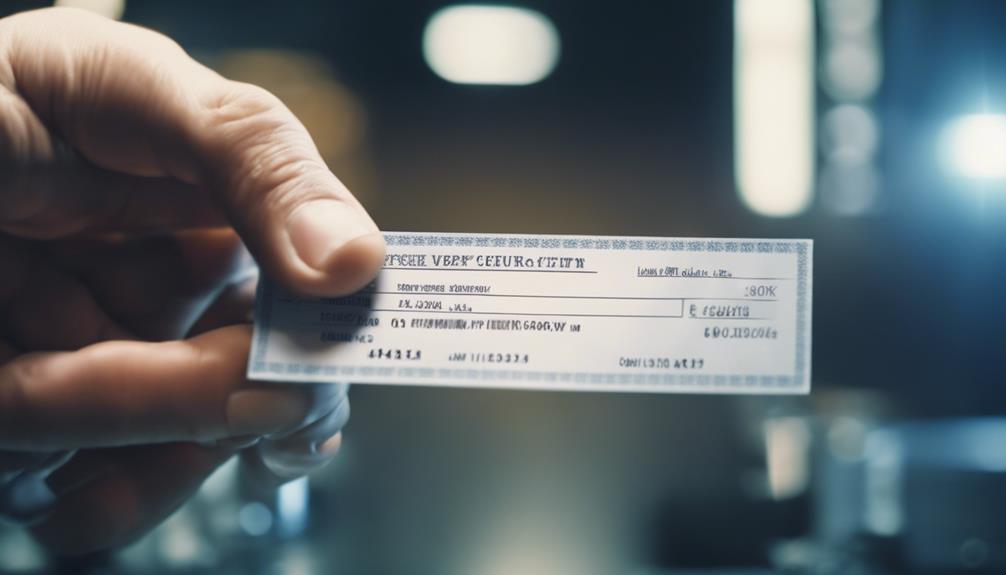As you navigate the intricate waters of understanding check processing services and the Check 21 Act, imagine unlocking a treasure chest filled with five key insights that could revolutionize your understanding of digital payments. From substitute checks to faster clearing processes, each key holds the potential to transform how you perceive the traditional world of paper checks. By grasping these essential elements, you are poised to embark on a journey towards a more efficient, secure, and expedited financial landscape.
Substitute Checks
Substitute checks, also known as image replacement documents, are legal copies of the original paper checks created for electronic processing. These checks play a crucial role in the modern banking system by facilitating electronic payments while maintaining the legal framework of traditional check transactions.
Check verification is a key aspect of substitute checks, ensuring that the electronic processing accurately reflects the original check details. By verifying the information on these substitute checks, financial institutions can guarantee the integrity and authenticity of the transactions.
When it comes to electronic payments, substitute checks offer a practical solution for converting paper checks into electronic formats. This conversion streamlines the payment process, making transactions faster and more efficient. Additionally, substitute checks enable businesses and individuals to embrace digital payment methods while still leveraging the familiarity and security of traditional checks.
Check Imaging
Through advanced technology, check imaging revolutionizes the way financial institutions process and handle checks in the modern digital era. Check imaging involves converting physical checks into digital images, allowing for faster processing, reduced errors, and improved efficiency. This digital transformation enables financial institutions to streamline check processing workflows, reduce costs associated with paper-based systems, and enhance overall customer experience.
Remote Deposit Capture
Utilizing remote deposit capture technology allows businesses to electronically deposit checks into their bank accounts without physically visiting a branch. This convenient method enables you to streamline your deposit process by simply scanning or photographing checks using a mobile device and submitting them through a secure online platform. Mobile deposits have become increasingly popular due to their time-saving benefits and accessibility.
When utilizing remote deposit capture, it’s essential to be aware of deposit limits set by your financial institution. These limits specify the maximum amount of funds you can deposit electronically within a certain timeframe. Understanding these limits is crucial to avoid any delays or issues with depositing larger checks. Some banks may have daily, weekly, or monthly deposit limits in place to manage risk and ensure security.
Faster Check Clearing
To expedite the processing of checks and facilitate quicker fund availability, advancements in technology have led to faster check clearing methods within the banking industry. Automated processing plays a key role in accelerating check verification and fraud prevention. By utilizing automated systems, banks can quickly verify the authenticity of checks, reducing the time it takes for funds to be made available to the recipient.
Efficiency benefits are significant when employing these faster check clearing methods. Automated processing not only speeds up the verification process but also enhances overall operational efficiency within financial institutions. With the ability to quickly verify checks, banks can prevent fraud more effectively, safeguarding both the bank and its customers from potential losses.
Truncation of Original Checks
Truncating original checks involves converting physical paper checks into electronic images for processing, streamlining the check clearing process and reducing the need for physical transportation. Check truncation is a fundamental aspect of modern banking that facilitates electronic processing, making it quicker and more efficient. By digitizing checks at the point of deposit, financial institutions can avoid the delays and risks associated with physically transporting paper checks between banks. Electronic processing allows for faster verification, settlement, and clearing of checks, benefiting both consumers and businesses by accelerating access to funds and improving cash flow. Additionally, electronic processing enhances security measures, reducing the likelihood of fraud and enabling easier monitoring of transactions. Embracing electronic check truncation not only expedites the payment cycle but also aligns with the industry’s shift towards digital solutions, paving the way for a more streamlined and secure financial ecosystem.
Frequently Asked Questions
Can I Deposit a Post-Dated Check Through Check Processing Services?
You can’t deposit a post-dated check through check processing services due to limitations. Be cautious about remote deposit risks when handling post-dated checks. It’s important to understand the rules and risks associated with depositing post-dated checks remotely.
Are There Any Limits on the Dollar Amount for Check Processing?
When it comes to check processing regulations, there are specific check amount limits you should be aware of. These limits vary depending on the service provider and the type of check being processed.
How Long Does It Take for a Bounced Check to Be Detected?
Bounced checks are typically detected quickly through advanced banking procedures. Detection speed varies but usually occurs within a few days. It’s crucial to monitor your account regularly to address any issues promptly.
Can I Dispute a Transaction Processed Through Check Imaging?
Sure, you can dispute a transaction processed through check imaging. The dispute process involves providing evidence of the discrepancy and questioning the check imaging validity. Be prepared to support your claim with relevant documentation.
Are There Any Security Risks Associated With Remote Deposit Capture?
When considering remote deposit capture, you should conduct a thorough risk assessment to identify potential security risks. Implementing robust fraud prevention measures is crucial to safeguard against unauthorized access and ensure the integrity of your financial transactions.



